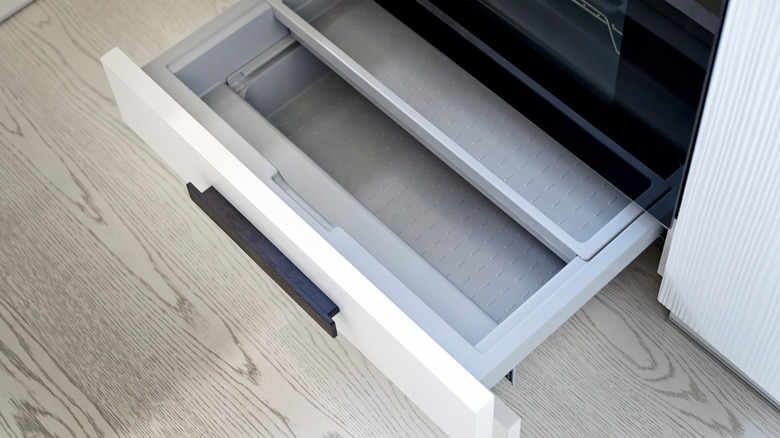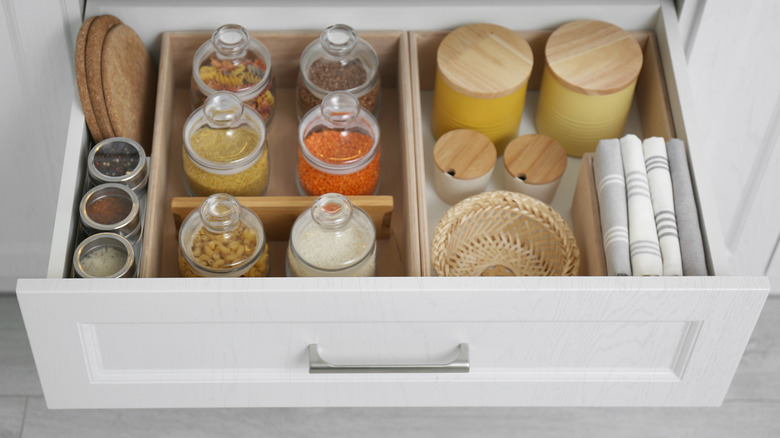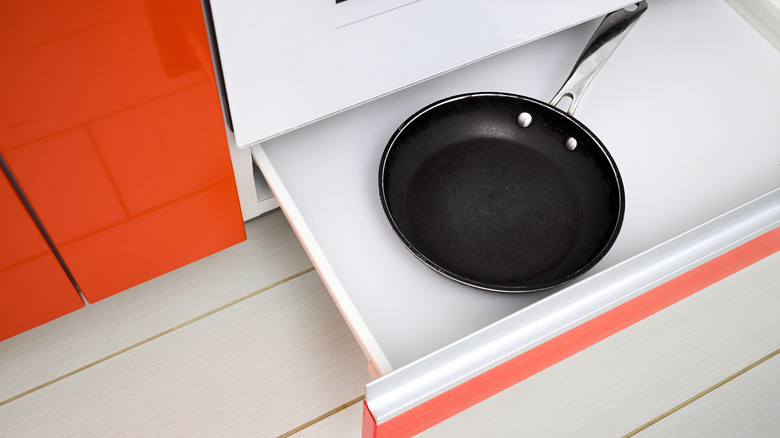Common Items You Should Avoid Storing In The Drawer Under Your Oven
And you thought it was made specifically to hide your kids' Halloween candy. Turns out the drawer under your oven may not be the best place to stash your children's sugary trick-or-treat loot after all. As much as its inconspicuousness makes it a stellar secret sanctum, the oven's bottom drawer is not designed to be a catch-all for random household odds and ends. In fact, for the safety of your house and family, you should avoid storing any items that are not heat resistant in the drawer under your oven.
There's a long-standing debate regarding the definitive role of an oven's bottom drawer. Some claim it's for storage, while others maintain that it's a broiler, and still others insist it's a warming drawer. In the end, the correct answer depends on the make and model of your oven. The only way you can unequivocally determine the purpose of the drawer is to consult your oven's user manual. If you can't find the hard copy that came with your appliance, look for a PDF version by doing a quick online search. In most cases, on electric ovens, the bottom drawer serves as a food warmer. However, if your oven is heated with gas, it's likely a pull-out broiler. Though, keep in mind, in either version the drawer could also simply serve as extra storage space especially if it does not feature a control panel, baking coil, racks, or rack frames.
Don't store flammable items in your oven's bottom drawer
Congratulations, you've positively ascertained your oven's bottom drawer is for storage. However, as conveniently positioned as it may be to the heart of your kitchen, it's unwise to store items in it that can burn when exposed to high temperatures. Resist using the drawer to stockpile paper goods, including dishes and cookbooks, as they can catch on fire when placed in close proximity to heat sources. Likewise, keep the drawer free of plastic bags, containers, and utensils, especially if they're made of melamine, which can release toxic fumes when exposed to temperatures exceeding 160 degrees Fahrenheit. In addition, bamboo placemats and wooden cutting boards are susceptible to cracking, drying out, and in some cases, burning when kept near high heat.
If kitchen storage is extremely tight in your home, a deep, empty oven drawer may seem inviting. However, for the sake of your health and safety, never place flammable items in the space, including cleaning supplies, cooking oils and alcohol, flour, sugar, cinnamon, and citrus rinds. Flour and sugar are carbohydrates that can ignite when they get hot enough. Moreover, cinnamon contains flammable compounds that can explode when subjected to high temperatures, while compressed orange, lemon, and lime peels produce a flammable substance that can erupt if stowed in the drawer underneath your oven. To protect your loved ones and your beloved home, it's best to store the aforementioned items in your kitchen's cabinets, drawers, or pantry instead.
What you should store in your oven's bottom drawer
While you may be thrilled to use your oven's sliding compartment like a bonus drop zone, consider its location. Situated directly beneath a major heating element, the drawer should only be used to stow items that are oven safe. Generally, this includes cookware and bakeware made of glass, ceramic, stainless steel, stoneware, and cast iron. In other words, commonly used kitchenware such as skillets, pots, casserole dishes, cake pans, cookie sheets, muffin tins, griddles, roasting pans, and pizza stones are all safe options. In addition, silicone is also considered oven safe as it can safely sustain temperatures up to 428 degrees Fahrenheit. The heat-resistant material is typically used to create oven-safe baking mats, molds, and mitts.
If you are unsure about an item's oven-safe status, look for a symbol featuring a square with wavy lines inside of it, icons that look like a small oven or oven rack, or text that reads "oven safe." Manufacturers usually place these labels or graphics on the bottom of cooking products to indicate they are able to withstand high temperatures without melting, warping, or otherwise being damaged. If you can't find manufacturer instructions, consider testing the kitchenware yourself. Simply place the item into an oven that has been preheated to 350 degrees Fahrenheit for 30 minutes. If during that time the piece hasn't melted, cracked, chipped, shattered, or broken, it is likely safe to store in your oven's bottom drawer.


